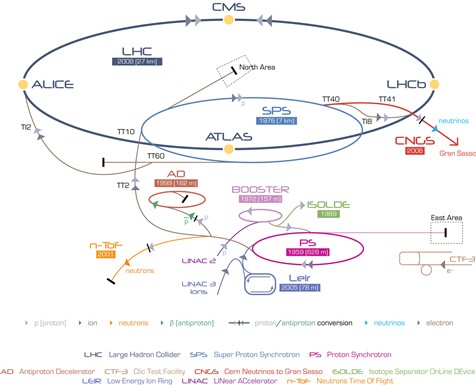The particle suppliers
Particles are supplied to the LHC by six accelerators inter-connected by several kilometres of transfer lines. This represents yet another complex chain of processes whereby particles are produced, bunched, synchronised and injected into the LHC at the precise moment it's ready to receive them. In other words, for collisions to be produced at the end of the chain, all the injectors must be in perfect working order.
Among all the questions asked by the many visitors to CERN, one in particular comes up time and time again: "Why don't you just connect the LHC directly to the proton source?" In other words, why do you need this whole chain of accelerators acting as an "injector" for the LHC?
Before colliding inside the LHC, particles first have to pass through no fewer than six different accelerators: the 90 keV duoplasmatron source, the 750 keV RFQ, the 50 MeV Linac 2, the 1.4 GeV synchrotron injector ("PS Booster" or PSB), the 25 GeV Proton Synchrotron (PS) and finally the 450 GeV Super-Proton-Synchrotron (SPS).
The primary function of each of these machines is of course to accelerate the beam up to the injection energy of the next machine. For beam stability reasons, the LHC cannot receive particles at too low energies. But the various links in the LHC injector chain do have other purposes.
Take the PS Booster, for example. The meticulous adjustment of its multi-turn injection system determines the small transverse dimensions of the proton beam, thus producing a high particle density and, through that, high luminosity in the LHC, which is the only one of CERN's accelerators operating as a collider. The Proton Synchrotron is responsible for creating the bunch structure, using radiofrequency to chop the beam into successive bunches. Finally, the SPS has the delicate task of inserting the bunch trains into the LHC at just the right place to ensure that they collide in the centre of the detectors.
It has taken many years to prepare these various machines to supply beams to the LHC, with varying numbers of bunches, bunch spacings and intensities. And while today's collisions were of beams consisting of just two bunches each, the injector chain is ready to supply the collider with nominal beams of 2,808 bunches of 1011 protons in each direction. This long period of preparation has finally borne fruit today, but the effects will only truly be felt once the LHC is ready to accept beams at their nominal intensity.


